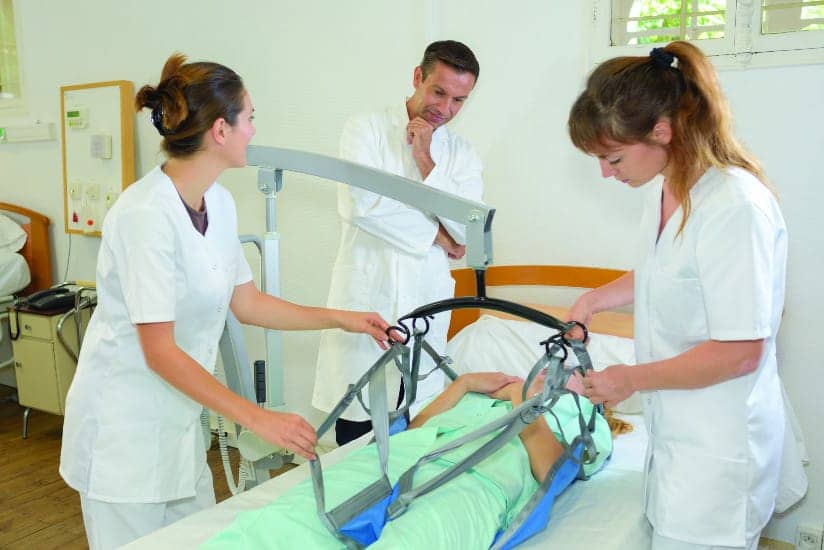PHOTO CAPTION: Functional tests that determine if a worker can lift, push, and pull certain weights to return to work at a job like that shown must meet all legal requirements.
How to ensure tests for industrial rehabilitation legally protect the rights of workers and employers.
By Virginia Marshall (Halling), PT
Professionals providing functional testing services have the potential to substantially impact the individuals to whom they provide testing services. These services influence decision-making related to hiring, job placement, and return to work after injury or illness. Reported results affect getting a job, returning to work after injury or illness, and qualification for disability benefits. There are laws protecting the rights of workers and employers. Professionals shouldn’t fear providing services in this legal environment so long as they have a fundamental understanding of how these laws impact the patients and clients they serve. Specifically, professionals should be reasonably aware of and reasonably assured that any functional testing services they provide meet the requirements of these laws.
Why Rehab Professionals Should Provide Functional Testing
The most common and costly workplace injuries today are related to musculoskeletal injuries. Sprains, strains, and tears remain the most frequent and costly group of injuries in the workplace for most employers across all industries, according to data from the Bureau of Labor Statistics for 2019.
Medical costs as well as other costs such as replacing an injured worker’s wages, covering the worker’s hours by paying another worker, legal costs, and more can all be reduced with a more function-based management plan. Rehab professionals providing function-based services to employers have often had their employer clients report outcomes with substantial reductions in both cost and days away from work.
Time is of the essence. In contrast with previously reported timelines of 6 to 12 months as being a critical benchmark for identifying the risk of long-term disability, more recent research reported on by the Job Accommodation Network suggests that a worker separated from his or her job only has a 50% chance of returning to work by the 12th week of separation. Within just a matter of weeks, the lack of meaningful return to work progress increases the likelihood that a worker will not return to their job or any job.
Return to Work Post-Injury/Illness
Historically, there has been an absence of adequate information related to the functional/physical demands of jobs which has severely limited all parties—physicians, patients, insurance representatives, and employers—from objectively managing return to work. This has bred a “100% or nothing” approach to placing workers back at work, where the worker is often kept out of work completely or placed in non-productive light duty jobs. This is a costly approach that often isn’t necessary if adequate information about the patient’s ability to do their job is addressed objectively.
Traditionally, the physician has been the one responsible for return-to-work recommendations, and has managed that responsibility by either providing a list of restrictions or fully releasing the patient to return to full duty. Restrictions include statements about lifting (ex: no lifting greater than 20 lbs), repetition (ex: no repetitive hand use), activity (ex: seated work only), and time (ex: no overtime). Restrictions are passed along to employers, who struggle to interpret them.
Since physicians do not actually perform functional testing with their patients, the restrictions are based on very limited information and intended to protect the patient from any harm. Often the restrictions are influenced by vague references to physical demands listed in job descriptions provided by human resources departments. If those documents are unavailable, the physician will ask the patient for information. Restrictions also tend to be conservative in nature because the physician does not have access to sufficient objective information about the patient’s job and must “do no harm.” Once the physician determines that the individual has adequately recovered from the injury or illness, the patient is released to full duty—again, based on what limited information is available.
Functional testing that is legally compliant brings a tremendous opportunity for rehab providers to provide functional testing services to physicians and also to employers. Functional testing gives physicians more evidence with which to base return-to-work recommendations. Well-designed functional testing that reflects work activities accurately serves as a communication tool regarding what a worker can safely do. This helps employers place an employee in a productive role during recovery and upon release to full duty. It also assures both the employer and the employee that returning to work will be safe and productive.
Rehab professionals regularly address functional abilities and limitations with their patients as they provide evaluation and treatment services. These professionals understand the relationship between injury, pathology, impairment, and function, and therefore are the ideal professionals for bringing this functional information to the forefront of patient management.
Table 1. Job Function Test: Transporter
| Job Task | Score | To Pass | Passed |
| 1. Position residents in bed or on gurney using a draw sheet | Pull 40 lbs | Pull 120 lbs | No |
| 2. Transfer residents (pivot transfer) | Lift 30 lbs Pull 40 lbs | Lift 60 lbs Pull 50 lbs | No |
| 3. Transfer residents using a lift device | Push 45lbs Pull 40 lbs | Push 40 lbs Pull 40 lbs | Yes |
| 4. Transport residents in wheelchair | Push 45 lbs | Push 20 lbs and 30 lbs | Yes |
Post-Offer of Employment Testing Services
Functional testing that has been based on measured and verified functional demands of the job can be used in making hiring and placement decisions. The same functional tests used to return workers to their jobs after injury or illness can assist employers with hiring decisions. So long as job-related functional tests have been verified by the employer’s experts, and meet certain legal requirements, functional tests designed specific to a job or group of jobs can be used in hiring, return to work post-illness or injury, fitness for duty, and disability management. The key is to have well-defined, well understood, legally compliant testing in place.
Legal Issues
The laws that govern the rights of workers in the workplace have been in place a long time and include EEOC Title VII (of the Civil Rights Act of 1964) and the ADAAA (Americans with Disabilities Act Amended Act). At the forefront of employment law is the requirement that all employers provide equal opportunity for employment and not discriminate against its workforce. Title VII prohibits employment discrimination based on race, color, religion, sex, and national origin. The ADAAA prohibits discrimination based on disability in several areas including rights to employment. Employment rights encompass the hiring process and protect workers throughout their course of employment.
Often, employers want to test job applicants to determine if they are a good fit for the job they have applied for. There are many forms of testing which may be related to knowledge, personality, skills, and physical ability. Functional testing is a form of physical ability testing. The law requires that any such tests be non-discriminatory and consistent with business necessity. The Uniform Guidelines on Employee Selection Procedures (UGESP) was adopted in 1978 with the intent to provide a uniform set of principles governing use of employee selection procedures. UGESP indicates that testing and selection procedures are to be consistent with employment laws and generally accepted validation standards.
Testing is required to be designed and delivered in such a way that is consistent with business necessity. Otherwise, the outcome of test results can lead to charges of discrimination due to adverse impact. Adverse impact is when a protected group has been discriminated against. Discovering an adverse impact often takes many years to come to light, and many more to be litigated or settled, which means if a company is found to be guilty of employment discrimination, the cost to the company and financial damage to the workers impacted can be high. Walmart was recently ordered to pay $20 million to women across the country for lost wages in the case EEOC v. Walmart Inc.
It is only in the instance that testing can be proven to be job-related and consistent with business necessity and meet validity criteria that charges of discrimination can be averted. Even so, employers must consider alternatives to avoid discriminating against protected groups if it is not an undue hardship.
Importance of Validity
The UGESP guidelines state that testing must meet either content, criterion-related, or construct validity standards. If testing is not found to meet the requirements of job-relatedness, consistency with business necessity, and validity, then the outcome of these tests leaves the employer vulnerable to discrimination verdicts as shown in the case above. A good reference for more details is the section on the EEOC’s website titled Employment Tests and Selection Procedures.
Any professionals providing work-related functional tests should be reasonably assured that the tests they are delivering have been designed to be in compliance with the above-mentioned laws that protect workers’ rights. While ultimately this is the responsibility of the employer, we do have a professional responsibility to ensure that to the best of our knowledge, functional testing services that we provide would meet anti-discrimination standards.
Conclusion
Rehab professionals can bring tremendous value to returning individuals to work—more efficiently, safely, and productively. If we provide any type of job-related functional testing services, it is important that we are assured that the functional tests we provide are designed to meet the legal requirements necessary to prevent discrimination in the workplace. Therefore, professionals designing and delivering functional testing should insist upon evidence of the accuracy of the functional and or physical demands to be tested.
Virginia “Ginnie” Marshall (Halling), PT, is chief executive officer of DSI Work Solutions Inc. For more information, contact [email protected].
Product Resources
The following companies offer products and services that can be helpful for industrial rehabilitation and work injury assessment:
DSI Work Solutions Inc
www.dsiworksolutions.com
KEY Functional Assessments Network
www.keymethod.com
WorkWell Prevention & Care
www.workwell.com
Sources
Sources the author consulted for this article include:
Bureau of Labor Statistics
EEOC Uniform Employee Selection Guidelines Questions and Answers
https://www.uniformguidelines.com/questionandanswers.html
EEOC v. Walmart Inc
EEOC Employment Tests and Selection Procedures
https://www.eeoc.gov/laws/guidance/employment-tests-and-selection-procedures
Job Accommodation Network





